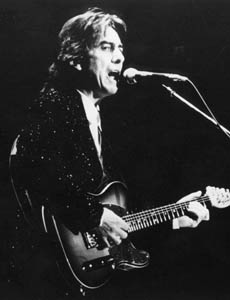![[Metroactive Music]](/music/gifs/music468.gif)
[ Music Index | Silicon Valley | Metroactive Home | Archives ]
Music From the Edge
George Harrison took musical chances that still resonate today
By Greg Cahill
BABY BOOMERS bawled, and even press coverage of the war in Afghanistan took a vacation for a couple of days as the world mourned the passing of a pop demigod. The shy Beatle, that's how the square newscasters and anchorwomen with bee-stung lips portrayed George Harrison, the Beatle guitarist who died Nov. 29 at age 58 of cancer.
Over and again, Harrison was depicted as a quiet sage who popularized sitars and mysticism, a frustrated songwriter who until the dissolution of the band in 1971 got rolled over by the Lennon/McCartney songwriting juggernaut. But there was another side to Harrison. He was the first Beatle to record a solo album--1968's innovative world-fusion feast Wonderwall Music--and his spacey 1969 synthesizer album, Electronic Sound (which gonzo music journalist Lester Bangs once dismissed as "diddley squat"), helped blaze the trail for the current crop of electronica musicians and the techno-sated rave generation.
At the time, Harrison--riding high as a charter member of the most commercially successful and critically acclaimed act in pop music--showed he could stretch far beyond the safe confines set by the Beatles PR machine. And, most importantly, that he had the courage to fail at a time when the Beatles were seen as capable of doing no wrong.
As The Magical Mystery Tour soundtrack album soared up the charts on the merits of multiple Lennon/McCartney hit singles, Harrison settled into the studio to produce a soundtrack of his own. The offbeat Wonderwall Music, an East/West excursion recorded in India and England with two groups of musicians, became the first project released on the Beatles' newly formed indie label, Apple Records--and the first commercial failure associated with a member of the band.
Yet Wonderwall Music is not without its artistic rewards. "With the subcontinental influence now firmly in the driver's seat, the score is mostly given over to the solemn, atmospheric drones of Indian music," pop critic Richard S. Ginell opined in the All Music Guide. "Yet as a whole, it's a fascinating, if musically slender mishmash of sounds from East and West, everything casually juxtaposed or superimposed without a care in the world."
The album's Eastern tracks include Indian vocals paired with electronic loops or tinged with slight rock beats, hinting at musical directions traveled decades later by Transglobal Underground, Banco De Gaia and other hybridized world-beat acts.
The Western tracks are, well, downright Western at times, as exhibited by the whimsical "Cowboy Museum." And then there's an ethereal mid-tempo rock instrumental reminiscent of Harrison's quirky Magical Mystery Tour track 'Flying,' the Beatles only instrumental. Adventurous in its own subtle manner, and overall rather pleasant.
On the other hand, Electronic Sound is experimental rock at its most demanding. Released just six months after Wonderwall Music, the album marks a creative burst by Harrison. It is the first complete album of synthesized music by a major rock star, and the antithesis of the rigid pop sound that put the Beatles in the spotlight: 100 percent synthesizer, no beats, no songs. It's just a guy noodling for two hours,î one anonymous net denizen has noted. It's probably the most un-liked Beatles-related album of all time.
On the project, the guitar picker teamed up with folkie-turned-electronic pioneer Bernie Krause, who in 1968 had collaborated with jazz musician Paul Beaver to create the groundbreaking synthesizer showcase The Nonesuch Guide to Electronic Music.
Krause, now an esteemed nature recordist living in Sonoma Valley, introduced the analog Moog synthesizer to the pop world in 1967 by setting up a demonstration model in a tent at the legendary Monterey Pop Festival. Together, Harrison and Krause recorded a pair of extended abstract tone poems: "No Time or Space" is a highly manipulated and sometimes strident sonic mix of white and pink noise, while "Under the Mersey Wall" is a deceptively shapeless and drifting mix of ambient electronic washes.
Universally panned at the time, and miles from the majestic synthesized sounds Harrison contributed that same year to the Beatles monumental Abbey Road album, Electronic Sound offers a candid glimpse at a fearless artist eager to explore the edge and unafraid of public opinion.
The shy Beatle? Don't believe it.
![]()
 Not So Shy After All: In his experiments with Eastern sounds and electronica, George Harrison proved to be a musical innovator on his own.
Not So Shy After All: In his experiments with Eastern sounds and electronica, George Harrison proved to be a musical innovator on his own.
From the December 6-12, 2001 issue of Metro, Silicon Valley's Weekly Newspaper.